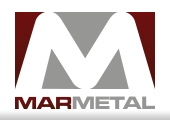
Casting Shapes
Marmetal can supply many different shapes and sizes in various alloys through all types of castings. Our extensive experience will help you find the right solution. Contact us today with your requirements and we’ll find the right solution for your next casting project. Common uses for cast products include bridge plates, wear plates, gear blanks, bushings, bearings and guides.
For more information, we highly recommend downloading the Copper Development Association’s Copper Casting Guide.
Sand Cast
To produce sand castings, molten metal is poured in to a sand mold and allowed to cool and solidify in to the shape of the mold. Sand castings can be produced in wide range of sizes and are ideal for basic shapes when affordability and quick turnaround are important. Sand castings are not suitable for complex shapes and large production run or for projects where surface finish is of importance.
Specifications
ASTM B22 ASTM B61 QQ-B-671
ASTM B148 ASTM B427 QQ-C-390
ASTM B584
Common Alloys
Continuous Cast
To produce continuous castings, molten metal is passed through a die which cools and solidifies the metal in to the desired shape. A series of temperature controlled rollers complete the tempering process allowing for control over the grain structure and mechanical properties. As a result, continuous cast products have greater durability and excellent machinability compared to conventional castings. Continuous Casting is ideal for the manufacture of a wide range of semi-finished profiles, including solid and hollow bars round bars, tubes and flats.
Specifications
ASTM B22 ASTM B505 QQ-C-390
ASTM B427
Common Alloys
C86300 C90300 C90500 C90700
C92200 C93700 C95400 C95500
C95510 C95520 C95800 C95900
Centrifugal Cast
To produce centrifugal castings, molten metal is poured in to a spinning hollow mold, on either a horizontal or vertical axis. The liquid metal is forced outward and solidifies in to the shape of the mold while impurities migrate to the ID where they are removed through subsequent machining. This process leads to a casting that is more dense, resulting in a product with greater machinability and less fatigue compared to other casting methods.
Specifications
ASTM B22 ASTM B271 ASTM B427
Common Alloys
C83600 C86300 C87300 C90300
C92200 C93200 C93700 C95500
C95510 C95510 C95520 C95800
